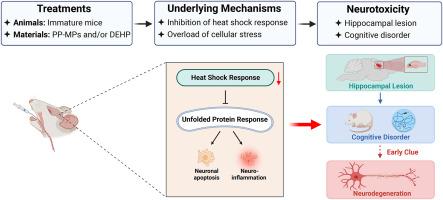Environmental Pollution ( IF 7.6 ) Pub Date : 2023-08-17 , DOI: 10.1016/j.envpol.2023.122406 Ge Yang 1 , Cunyi Gong 1 , Xinyue Zheng 1 , Fei Hu 1 , Jie Liu 2 , Tian Wang 3 , Xinyue Chen 1 , Min Li 1 , Zhihong Zhu 4 , Ling Zhang 5 , Rui Li 1

|
Studies have shown that exposure to either microplastics (MPs) or di-(2-ethylhexyl) phthalic acid (DEHP) alone can cause neurotoxicity in animals, but it remains uncertain whether and to what extent co-exposure to these two substances, which often occur together in reality, can also induce neurotoxicity. This study aimed to investigate the neurotoxicity and molecular mechanisms of combined exposure to DEHP and polypropylene microplastics (synthetic PP-MPs were used), the microplastics most commonly encountered by young children, in immature mice. The results showed that exposure to PP-MPs and/or DEHP did cause neurotoxic effects in immature mice, including induction of neurocognitive and memory deficits, damage to the CA3 region of the hippocampus, increased oxidative stress, and decreased AChE activity in the brain. The severity of the neurotoxicity increased with increasing concentrations of PP-MPs, combined exposure to PP-MPs and DEHP exhibited additive or synergistic effects. Transcriptomic analyses revealed that the PP-MPs and/or DEHP exposure altered the expression profiles of gene clusters involved in the stress response, and in protein processing in endoplasmic reticulum. Quantitative analyses further indicated that PP-MPs and/or DEHP exposure inhibited the activity of the heat shock response mediated by heat shock transcription factor 1, while chronically activated the unfolded protein response, consequently inducing neurotoxicity through neuronal apoptosis and neuroinflammation in the immature mice. As a pioneer study to highlight the neurotoxicity induced by combined exposure to PP-MPs and DEHP in immature mice, this research provides new insights into mitigating the health risks of PP-MPs and DEHP exposure in young children.
中文翻译:

聚丙烯微塑料和 DEHP 联合暴露诱发未成熟小鼠神经退行性疾病的早期线索和分子机制
研究表明,单独接触微塑料 (MP) 或邻苯二甲酸二(2-乙基己基) 酸 (DEHP) 会导致动物神经毒性,但尚不确定是否以及在多大程度上同时接触这两种物质,这通常会导致动物中毒。现实中同时发生,也会诱发神经毒性。本研究旨在探讨未成熟小鼠联合接触 DEHP 和聚丙烯微塑料(使用合成 PP-MP)(幼儿最常遇到的微塑料)的神经毒性和分子机制。结果表明,接触 PP-MP 和/或 DEHP 确实会对未成熟小鼠产生神经毒性作用,包括诱导神经认知和记忆缺陷、海马 CA3 区损伤、氧化应激增加以及大脑中 AChE 活性降低。神经毒性的严重程度随着 PP-MP 浓度的增加而增加,PP-MP 和 DEHP 的联合暴露表现出累加或协同效应。转录组分析表明,PP-MP 和/或 DEHP 暴露改变了参与应激反应和内质网蛋白质加工的基因簇的表达谱。定量分析进一步表明,PP-MPs 和/或 DEHP 暴露抑制了热休克转录因子 1 介导的热休克反应活性,同时长期激活未折叠蛋白反应,从而通过神经元凋亡和神经炎症诱导未成熟小鼠的神经毒性。作为一项强调未成熟小鼠联合接触 PP-MP 和 DEHP 所引起的神经毒性的开创性研究,这项研究为减轻幼儿接触 PP-MP 和 DEHP 的健康风险提供了新的见解。














































 京公网安备 11010802027423号
京公网安备 11010802027423号